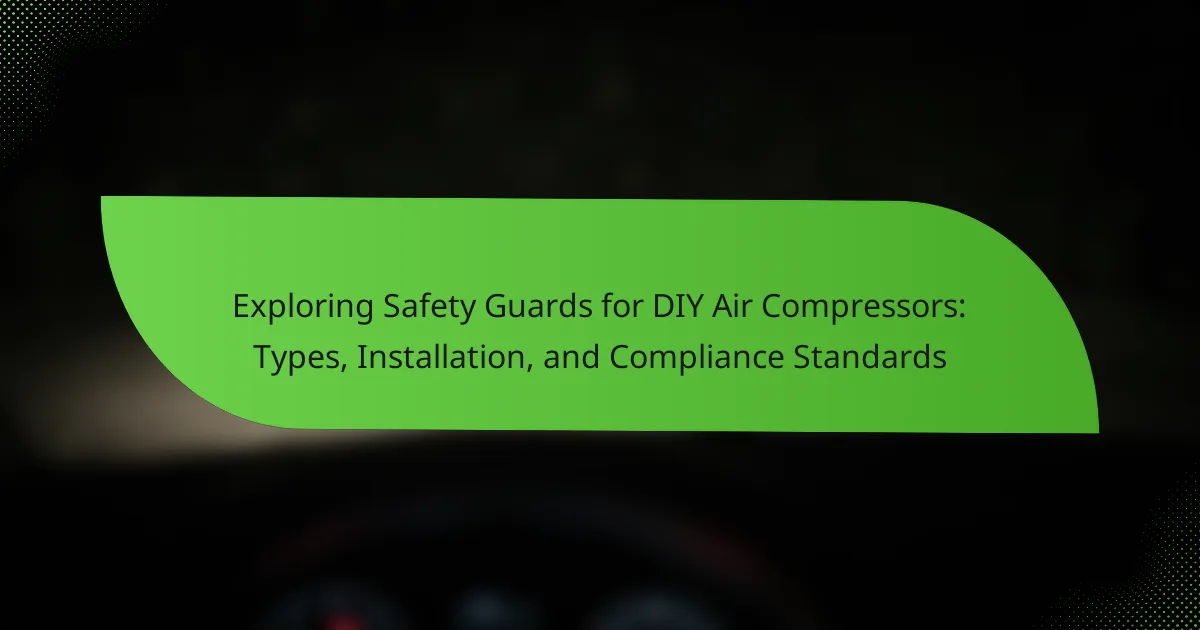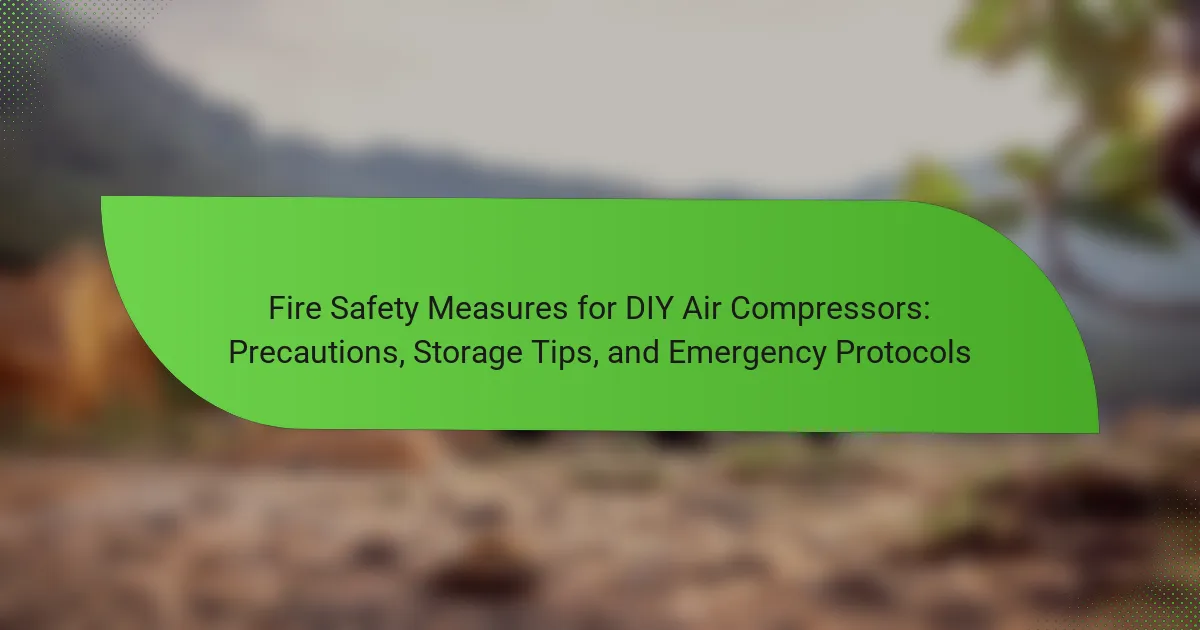Electrical safety features in DIY air compressors are critical for ensuring safe operation and preventing accidents. Key protection mechanisms include thermal overload protection, which prevents motor overheating; circuit breakers, which interrupt electrical flow during overloads; and pressure relief valves, which release excess pressure to avoid tank rupture. Compliance with safety ratings such as UL and CE indicates adherence to established electrical safety standards. Additionally, guidelines for safe use involve proper grounding, the use of Ground Fault Circuit Interrupter outlets, and regular inspections of electrical components. Understanding these features and guidelines is essential for users to mitigate risks associated with electrical hazards in DIY air compressor applications.
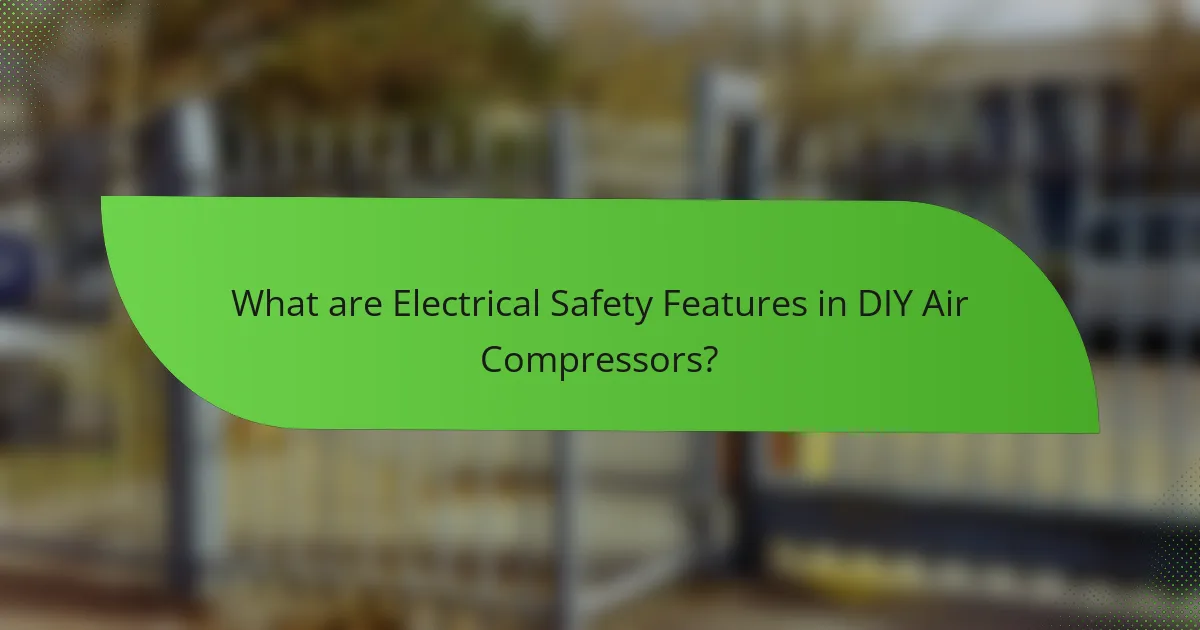
What are Electrical Safety Features in DIY Air Compressors?
Electrical safety features in DIY air compressors include thermal overload protection, circuit breakers, and grounded plugs. Thermal overload protection prevents the motor from overheating by shutting it off when it reaches a certain temperature. Circuit breakers interrupt the electrical flow in case of a short circuit or overload, enhancing safety. Grounded plugs ensure that any electrical faults are redirected safely to the ground, reducing the risk of electric shock. These features are essential for preventing accidents and ensuring safe operation during use.
Why are Electrical Safety Features important in DIY Air Compressors?
Electrical safety features are crucial in DIY air compressors to prevent accidents and injuries. These features help to mitigate risks associated with electrical malfunctions. For instance, circuit breakers can cut off power in case of overloads. This prevents potential fires or equipment damage. Ground fault circuit interrupters (GFCIs) protect users from electric shocks. They automatically shut off power when a fault is detected. Additionally, proper insulation and housing prevent accidental contact with live wires. According to the National Fire Protection Association, electrical failures are a leading cause of home fires. Therefore, incorporating safety features is essential for safe operation.
What risks are associated with DIY Air Compressors without safety features?
DIY air compressors without safety features pose significant risks. These risks include potential explosions due to over-pressurization. Without proper relief valves, pressure can build up beyond safe limits. This can lead to catastrophic failures and injuries. Additionally, lack of safety guards increases the chance of accidental contact with moving parts. Users may also face electrical hazards from faulty wiring or components. The absence of thermal overload protection can lead to overheating. Overheating may cause fires or equipment damage. Overall, DIY air compressors without safety features compromise user safety and equipment reliability.
How do safety features enhance user protection?
Safety features enhance user protection by preventing accidents and minimizing risks. They include mechanisms like pressure relief valves and automatic shut-off systems. These features detect unsafe conditions and respond accordingly. For example, pressure relief valves release excess pressure to avoid explosions. Automatic shut-off systems cut power when a fault is detected. According to the Consumer Product Safety Commission, such features significantly reduce injury rates. Implementing these safety measures in DIY air compressors ensures safer operation for users.
What types of Electrical Safety Features are commonly found in DIY Air Compressors?
Common electrical safety features in DIY air compressors include thermal overload protection, circuit breakers, and pressure relief valves. Thermal overload protection prevents motor overheating by shutting off the compressor when it exceeds a safe temperature. Circuit breakers protect against electrical faults by interrupting the power supply in case of short circuits. Pressure relief valves prevent excessive pressure build-up, ensuring safe operation and preventing potential explosions. These features are essential for maintaining safety during use and preventing accidents.
What is the role of overload protection in air compressors?
Overload protection in air compressors prevents damage from excessive current. It automatically shuts down the compressor when it detects a current draw beyond safe levels. This protection mechanism safeguards the motor from overheating and potential failure. Overload protection is crucial for maintaining the longevity of the compressor. It also enhances user safety by reducing the risk of electrical fires. Many air compressors are equipped with thermal overload relays for this purpose. These relays monitor temperature and current levels continuously. If the threshold is exceeded, the relay interrupts the power supply, ensuring safe operation.
How does thermal protection work in air compressors?
Thermal protection in air compressors prevents overheating by monitoring the temperature of the motor. When the temperature exceeds a preset limit, the thermal protection system activates. This system typically uses a thermal switch or sensor. Once activated, it interrupts the power supply to the motor. This interruption allows the compressor to cool down and prevents damage. After cooling, the system can automatically reset, allowing operation to resume. Thermal protection is essential for maintaining the longevity and efficiency of air compressors. It significantly reduces the risk of motor burnout and other heat-related failures.
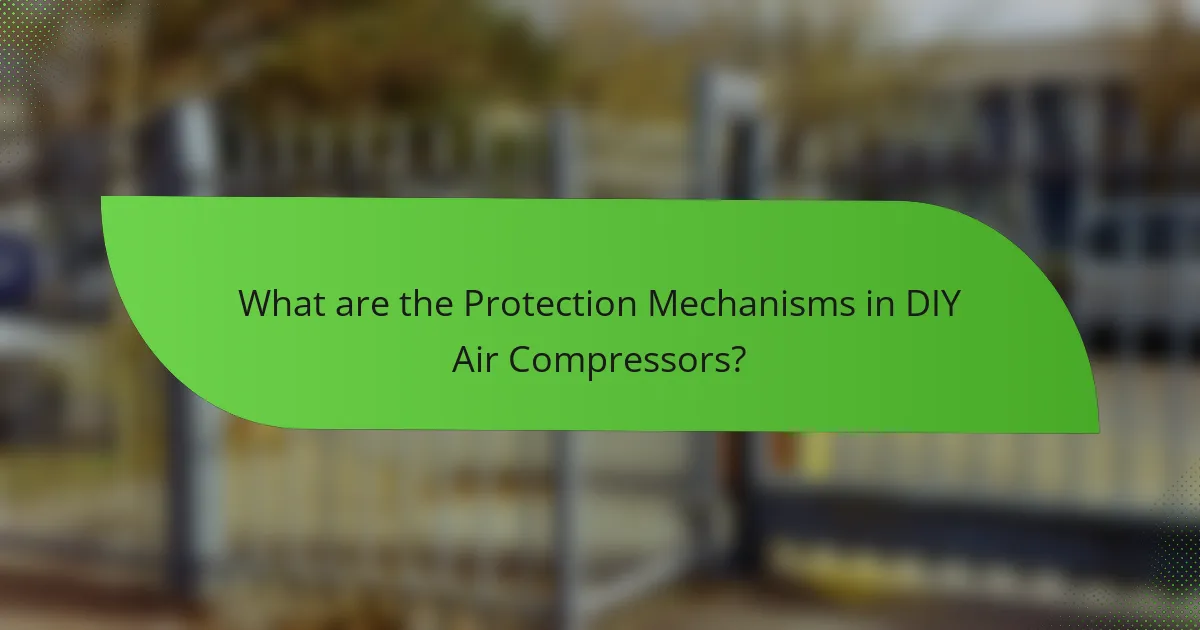
What are the Protection Mechanisms in DIY Air Compressors?
Protection mechanisms in DIY air compressors include thermal overload protectors, pressure relief valves, and circuit breakers. Thermal overload protectors prevent overheating by shutting off the compressor when it exceeds a safe temperature. Pressure relief valves release excess pressure to avoid tank rupture, ensuring safe operation. Circuit breakers protect against electrical overloads by interrupting the power supply when current exceeds a preset limit. These mechanisms are essential for preventing accidents and ensuring the longevity of the compressor. Implementing these features significantly enhances user safety during operation.
How do circuit breakers function in air compressors?
Circuit breakers in air compressors protect electrical circuits from overloads and short circuits. When the compressor draws too much current, the circuit breaker automatically interrupts the flow of electricity. This prevents overheating and potential fires. Circuit breakers reset easily after tripping, allowing safe operation once the issue is resolved. They are essential for maintaining electrical safety in air compressors. According to the National Fire Protection Association, proper circuit protection is vital to prevent electrical hazards.
What are the benefits of using circuit breakers in DIY air compressors?
Using circuit breakers in DIY air compressors provides essential safety and protection. They prevent electrical overloads, which can cause fires or equipment damage. Circuit breakers automatically interrupt the power supply when the current exceeds safe levels. This feature protects both the compressor and the user from potential hazards. Additionally, they allow for easy reset after tripping, enhancing convenience. According to the National Fire Protection Association, equipment failure is a leading cause of electrical fires. Thus, incorporating circuit breakers significantly reduces these risks in DIY air compressor setups.
What are the limitations of circuit breakers?
Circuit breakers have several limitations. They may not respond quickly enough to certain types of electrical faults. For instance, slow-acting breakers can fail to trip during a short circuit, leading to potential damage. Circuit breakers also have a limited lifespan, typically rated for around 10,000 operations. After this, they may not function reliably. Additionally, they can be affected by environmental factors like temperature and humidity. High inrush currents can also cause nuisance tripping, interrupting the power supply unnecessarily. Lastly, circuit breakers do not provide protection against all electrical hazards, such as ground faults unless specifically designed for it.
What is the significance of fuses in air compressor safety?
Fuses are crucial for air compressor safety as they prevent electrical overloads. They act as a protective device that interrupts the circuit when excessive current flows. This interruption helps to prevent potential fires and equipment damage. Fuses ensure that the compressor operates within safe electrical limits. According to the National Fire Protection Association, electrical failures are a leading cause of fires. By using fuses, air compressors can mitigate these risks significantly. Regularly checking and replacing fuses is essential for maintaining safety standards. Proper fuse ratings should match the compressor’s specifications to ensure effectiveness.
How do fuses differ from circuit breakers in air compressors?
Fuses and circuit breakers serve as protective devices in air compressors, but they function differently. Fuses are one-time use devices that melt when excessive current flows through them. This interruption stops the current and protects the compressor from damage.
In contrast, circuit breakers can be reset after tripping due to overload or short circuits. They use a mechanical switch that opens the circuit when a fault occurs.
Fuses typically respond faster to overcurrent situations than circuit breakers. However, circuit breakers provide the convenience of being reusable.
Fuses require replacement after an overload, while circuit breakers can be reset with a simple switch. This fundamental difference affects maintenance and operational efficiency in air compressors.
What are the recommended fuse ratings for DIY air compressors?
The recommended fuse ratings for DIY air compressors typically range from 10 to 20 amps. This range is suitable for most small to medium-sized compressors. A 15-amp fuse is commonly used for compressors with a power rating around 1.5 horsepower. For larger models, a 20-amp fuse may be necessary. These ratings help protect the compressor from overload and potential damage. Always consult the manufacturer’s specifications for precise ratings. Adhering to these guidelines ensures safe operation and prevents electrical hazards.
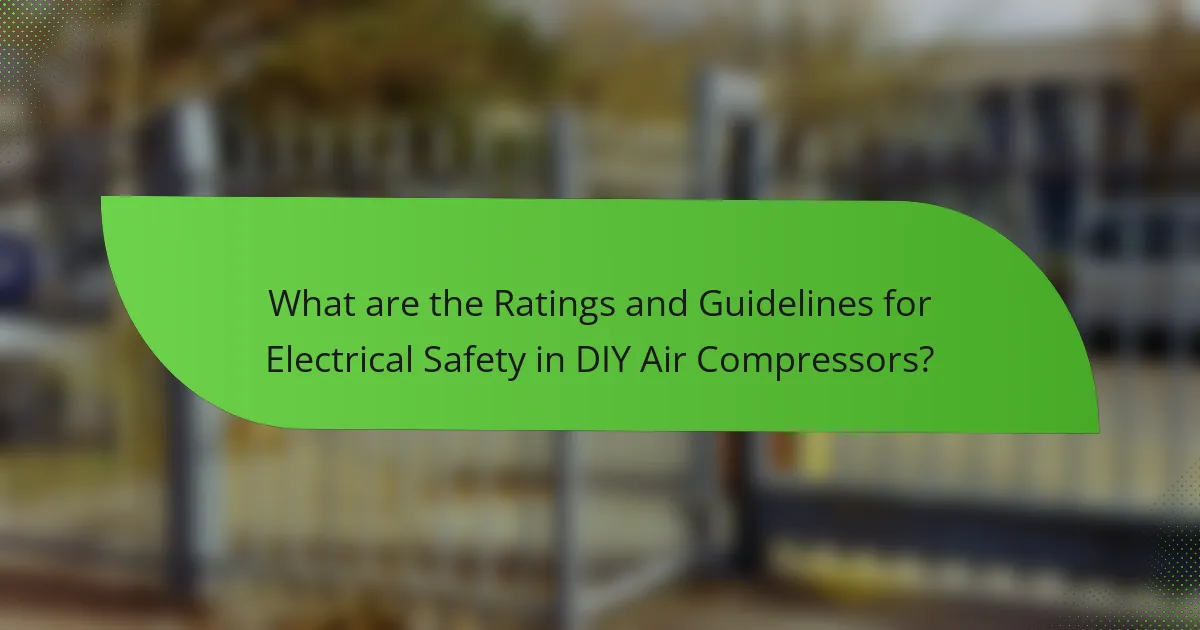
What are the Ratings and Guidelines for Electrical Safety in DIY Air Compressors?
Electrical safety ratings for DIY air compressors include compliance with UL (Underwriters Laboratories) and CE (Conformité Européenne) standards. These ratings indicate that the compressor meets specific safety requirements for electrical components. Guidelines for electrical safety involve ensuring proper grounding, using appropriate circuit breakers, and following manufacturer instructions. Additionally, using GFCI (Ground Fault Circuit Interrupter) outlets can prevent electrical shocks. Regular inspections of cords and connections are crucial for maintaining safety. Following these guidelines helps mitigate risks associated with electrical hazards in DIY air compressor use.
What safety ratings should you look for in DIY Air Compressors?
Look for safety ratings such as UL (Underwriters Laboratories), CSA (Canadian Standards Association), and CE (Conformité Européenne) when choosing DIY air compressors. UL certification indicates compliance with safety standards in the United States. CSA certification ensures safety standards are met in Canada. CE marking shows compliance with European Union safety, health, and environmental requirements. These ratings help ensure the compressor has been tested for electrical safety and performance. Additionally, check for features like overload protection and pressure relief valves, which enhance safety during operation.
How do UL and CE ratings impact the safety of air compressors?
UL and CE ratings significantly impact the safety of air compressors. UL (Underwriters Laboratories) ratings indicate that a product has been tested for safety standards in the United States. CE (Conformité Européenne) markings show compliance with safety standards in the European Economic Area. Both ratings help ensure that air compressors are designed to minimize risks such as electrical shock, fire hazards, and mechanical failures.
Air compressors with UL ratings have undergone rigorous testing for electrical safety and performance. This testing assesses potential hazards and verifies that the product meets established safety criteria. Similarly, CE certification ensures that the air compressor complies with relevant European directives regarding safety and health.
The presence of these ratings provides consumers with confidence in the reliability and safety of the air compressors they purchase. Products without these ratings may not have undergone the same level of safety scrutiny, potentially leading to increased risks. Therefore, UL and CE ratings serve as critical indicators of safety for air compressors, protecting users from potential dangers associated with their operation.
What does the IP rating indicate for air compressor safety?
The IP rating indicates the level of protection an air compressor has against dust and water ingress. It stands for Ingress Protection and is followed by two digits. The first digit represents protection against solid objects, while the second digit indicates protection against liquids. For example, an IP65 rating means the compressor is dust-tight and can withstand water jets. This rating is crucial for ensuring the safety and durability of air compressors in various environments. High IP ratings reduce the risk of electrical faults and enhance the reliability of the equipment.
What guidelines should be followed for safe usage of DIY Air Compressors?
Ensure proper ventilation when using DIY air compressors. This prevents the buildup of harmful fumes. Always check for leaks in hoses and connections before operation. Leaks can lead to pressure loss and potential hazards. Wear appropriate personal protective equipment, such as goggles and ear protection. This minimizes the risk of injury during use. Maintain a safe distance from flammable materials while operating the compressor. Flammable substances can ignite from sparks. Regularly inspect the compressor for wear and tear. A well-maintained unit operates more safely and efficiently. Follow the manufacturer’s instructions for pressure settings and usage guidelines. Adhering to these instructions ensures safe operation.
How can users ensure proper maintenance of safety features?
Users can ensure proper maintenance of safety features by regularly inspecting the air compressor for any signs of wear or damage. This includes checking the power cord, plug, and safety switches for fraying or malfunction. Users should also clean the compressor’s air filter to prevent dust and debris buildup. Regularly testing the safety features, such as pressure relief valves, ensures they function correctly. Additionally, users should follow the manufacturer’s maintenance schedule outlined in the user manual. Keeping the compressor in a dry and clean environment helps prevent corrosion and electrical issues. Finally, documenting maintenance activities can help track the condition of safety features over time.
What common mistakes should be avoided when using DIY air compressors?
Common mistakes to avoid when using DIY air compressors include neglecting safety precautions. Users often fail to wear appropriate personal protective equipment. This oversight can lead to serious injuries. Another mistake is overloading the compressor beyond its capacity. This can cause overheating and damage to the unit. Additionally, not properly maintaining the compressor is a frequent error. Regular maintenance ensures optimal performance and longevity. Users may also forget to drain the moisture from the tank. Accumulated moisture can lead to rust and corrosion. Lastly, improper storage of the compressor can result in damage. Storing it in damp or unprotected areas can affect its functionality.
What are the best practices for ensuring electrical safety in DIY Air Compressors?
To ensure electrical safety in DIY air compressors, always use a grounded outlet. This prevents electrical shock by directing excess current safely to the ground. Next, utilize circuit breakers or fuses to protect against overloads. These devices automatically cut off power when currents exceed safe levels.
Regularly inspect power cords for damage or fraying. Damaged cords can lead to short circuits or fires. Additionally, use proper gauge extension cords to prevent overheating. The wrong gauge can increase resistance and create a fire hazard.
Maintain a dry workspace to avoid moisture exposure. Water and electricity are a dangerous combination, increasing the risk of shock. Always follow the manufacturer’s guidelines for installation and use. These guidelines provide essential safety information specific to the compressor model.
Lastly, wear appropriate personal protective equipment (PPE), such as insulated gloves and safety goggles. This minimizes injury risk while working with electrical components.
How can users implement safety checks before operating air compressors?
Users can implement safety checks by inspecting the air compressor for any visible damage. They should ensure that all connections are secure and free from wear. Checking the power supply for proper voltage and grounding is essential. Users must also verify that the safety relief valve is functioning correctly. Additionally, they should inspect the hoses and fittings for leaks or cracks. Ensuring that the compressor is placed on a stable surface can prevent accidents. Finally, wearing appropriate personal protective equipment is crucial for user safety. These checks help prevent accidents and ensure the compressor operates safely.
What troubleshooting tips can enhance safety during use?
Ensure proper grounding of the air compressor to enhance safety during use. Check the power supply for correct voltage and amperage specifications. Inspect the power cord for any damage or fraying before use. Ensure that all connections are secure and free from moisture. Regularly examine the compressor for leaks or unusual noises that may indicate a malfunction. Use a surge protector to prevent damage from electrical spikes. Follow the manufacturer’s guidelines for maintenance and operation. These steps significantly reduce the risk of electrical hazards and enhance overall safety.
The main entity of this article is electrical safety features in DIY air compressors. It provides an overview of essential safety mechanisms such as thermal overload protection, circuit breakers, and grounded plugs, which are vital for preventing accidents and ensuring safe operation. The article discusses the importance of these features, the risks associated with compressors lacking safety measures, and the role of various protection mechanisms. Additionally, it covers safety ratings, guidelines for safe usage, and best practices to enhance electrical safety in DIY air compressors.
